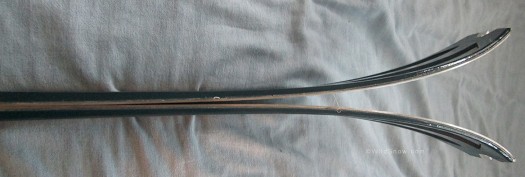Notes from the workshop: Drilling the Cho Oyu for bindings reveals a thick metal binding mount plate. Say goodbye to unreliable inserts (they were a good idea, but ideas are sometimes different in the real). Overall feel of the Cho Oyu is yes, no mass. Flex is supple but not wimpy. Dark coloring is a disappointment due to topskin ice formation, but other brands and models are not immune to the style victim syndrome, so that’s a wash.
Uphill with skins the floaty weight of the Cho is obvious. Said to be accomplished via plentiful carbon fiber, mass of my 174 is a scanty 1,183 grams per ski. That places easily in what we’re calling the “one kilo weight class.” See our backcountry ski weight charts. The proprietary Dynafit skin attachment system is still my favorite, but I’d like to see the tip notches cut longer with a narrower entry since skins will sometimes stretch and creep in a way that causes the tip attachment tab to pop out of the notch if it’s not nestled in there nice and deep. Skis with large tips and lots of sidecut can sometimes feel a bit odd on the up, when they tend to hook out of your travel direction and need a slight correction during each stride. I didn’t notice much of this effect with the Cho; kudos to Dynafit for not going overboard with the wasp profile.
I skied the “Chodee” for more than 25 days last winter and spring, in everything from perfect powder to wind crust and frozen corn. Overall I like the ski — it is a top choice for touring. I did notice the 88 mm waist and “waspie” 124/88/110 profile and 16,11,15 variable radius sidecut, both of which made the ski less forgiving in difficult snow than wider planks with an easier radius. For full-on powder fests such as a Candian winter hut trip I’d pick a different ski, but as a quiver-of-one for traveling to unknown conditions, fully human powered, I’d be comfortable with the Chodee living in my ski luggage.
On the piste, Cho Oyu is smoother than some of the other lightweight “carbon” type skis I tested last winter, probably due to them still having some wood in the core. But I would not call them particularly damp, and wow are they noisy on frozen chowder — consider ear plugs in that situation. While the Chodee has what Dynafit calls “Scoop Rocker” in the tip area extending about 10cm into the running surface, I did not notice much of a rocker effect in this ski. It did feel easier to initiate a turn than with a fully non-rockered ski, but this is not the slarvy pow ski that I’ve found addictive when conditions welcome such a plank. Technician skiers should also note that this ski is cambered at about 2mm per.

Chodee tip rocker, Dynafit calls it 'Scoop Rocker.' Pretty much what most of us call a 'slow rise' tip.
Dynafit ski fans should note that Cho Oyu appears to be a replacement for the Seven Summits, which has been incredibly popular in Europe and gained a modest following here in the New World. Having skied both planks extensively I’d say that’s a fair take, though I can’t say for certain that if you like 7 Summits you’ll like the Cho — though the concept is the same: narrower touring ski with some sidecut, built specifically for human powered skiing in all conditions, lack of weight a priority.
Rocker addicts might scoff, but a barrel stave ski is not always the ideal, mainly in terms of how long a ski you end up needing. In a fully rockered ski I’d want a longer length than the Chodee 174 I was on. Thus, the important point here is that for core ski alpinism, less rocker and a bit more sidecut can yield a short, low mass tool that carries nicely on your pack, feels like wings on your feet — and skis well. That is Cho Oyu. Definitely a WildSnow Ultimate Quiver pick for 2013/14. Shop for it.
WildSnow.com publisher emeritus and founder Lou (Louis Dawson) has a 50+ years career in climbing, backcountry skiing and ski mountaineering. He was the first person in history to ski down all 54 Colorado 14,000-foot peaks, has authored numerous books about about backcountry skiing, and has skied from the summit of Denali in Alaska, North America’s highest mountain.


